 W
WTea culture is defined by the way tea is made and consumed, by the way the people interact with tea, and by the aesthetics surrounding tea drinking.
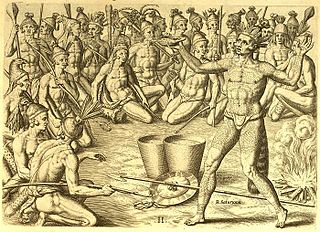 W
WBlack drink is a name for several kinds of ritual beverages brewed by Native Americans in the Southeastern United States. Traditional ceremonial people of the Yuchi, Caddo, Chickasaw, Cherokee, Choctaw, Muscogee and some other Indigenous peoples of the Southeastern Woodlands use the black drink in purification ceremonies. It was occasionally known as white drink because of the association of the color white with peace leaders in some Native cultures in the Southeast.
 W
WBubble tea is a tea-based drink that originated in Taiwan in the early 1980s. It most commonly consists of tea accompanied by chewy tapioca balls, but it can be made with other toppings as well.
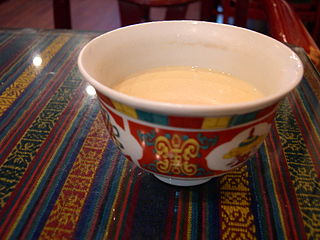 W
WButter tea, also known as po cha, cha süma, Mandarin Chinese: sūyóu chá or gur gur cha in the Ladakhi language, is a drink of the people in the Himalayan regions of Nepal, Bhutan, India and Tibet and other Western regions of modern-day China. Traditionally, it is made from tea leaves, yak butter, water, and salt, although butter made from cow's milk is increasingly used, given its wider availability and lower cost.
 W
WButterfly pea flower tea, commonly known as blue tea, is a caffeine-free herbal tea, or tisane, beverage made from a decoction or infusion of the flower petals or even whole flower of the Clitoria ternatea plant. Clitoria ternatea is also known as butterfly pea, blue pea, Aprajita, Cordofan pea, Blue Tea Flowers or Asian pigeonwings.
 W
WCha chaan teng, often called Hong Kong-style cafés in English, is a type of restaurant that originated in Hong Kong. Cha chaan teng are commonly found in Hong Kong, Macau, and parts of Guangdong. Due to the waves of mass migrations from Hong Kong in the 1980s, they are now established in major Chinese communities in Western countries such as Australia, Canada, the United Kingdom, and the United States. The cafés are known for eclectic and affordable menus, which include dishes from Hong Kong cuisine and Hong Kong-style Western cuisine. They draw comparisons to Western Cafés due to their casual settings, as well as menus revolving around coffee and tea.
 W
WCompressed tea, called tea bricks, tea cakes or tea lumps, and tea nuggets according to the shape and size, are blocks of whole or finely ground black tea, green tea, or post-fermented tea leaves that have been packed in molds and pressed into block form. This was the most commonly produced and used form of tea in ancient China prior to the Ming Dynasty. Although tea bricks are less commonly produced in modern times, many post-fermented teas, such as pu-erh, are still commonly found in bricks, discs, and other pressed forms. Tea bricks can be made into beverages like tea or eaten as food, and were also used in the past as a form of currency.
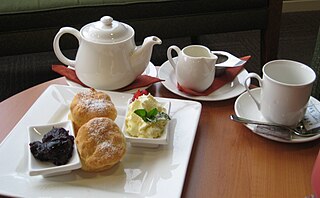 W
WA cream tea is a form of afternoon tea, consisting of tea served with a combination of scones, clotted cream, jam, and sometimes butter. Though a particular speciality of Devon and Cornwall, cream teas are sold in tea rooms throughout England, and in some other parts of the Commonwealth.
 W
WThe traditional cucumber sandwich is composed of thin slices of cucumber situated between two slices of fresh crustless, lightly buttered white bread. The sandwich originated in the United Kingdom, and modern variants, largely of United States origin, introduce cream cheese, mayonnaise, chopped dill or spices, and salmon, and may be served on brown bread, or common crusted white bread. One specific US variant includes benedictine, a green soft spread made from cucumbers and cream cheese.
 W
WDim sum is a large range of small Chinese dishes that are traditionally enjoyed in restaurants for breakfast and lunch. Most modern dim sum dishes originated in Guangzhou in southern China and are commonly associated with Cantonese cuisine, although dim sum dishes also exist in other Chinese cuisines. In the tenth century, when the city of Guangzhou (Canton) began to experience an increase in commercial travel, travellers concurrently began to frequent teahouses for small-portion meals with tea called yum cha, or "drink tea" meals. Yum cha includes two related concepts. The first is "yat jung leung gin" (一盅兩件), which translates literally as "one cup, two pieces". This refers to the custom of serving teahouse customers two pieces of delicately made food items, savory or sweet, to complement their tea. The second is dim sum (點心) and translates literally to "touching heart", the term used to designate the small food items that accompanied the tea drinking.
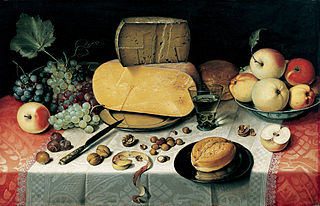 W
WElevenses is a short break taken at around 11:00 am to consume a drink or snack. The names and details vary among countries.
 W
WHong Kong-style milk tea is a tea drink made from black tea and milk. It is usually part of lunch in Hong Kong tea culture. Hongkongers consume approximately a total of 900 million glasses/cups per year. Although originating from Hong Kong, it can also be found overseas in restaurants serving Hong Kong cuisine and Hong Kong-style western cuisine. In the show Top Eat 100, which aired on 4 February 2012, Hong Kong-style milk tea was listed as the 4th most popular food/drink in Hong Kong. The unique tea making technique is listed on the representative list of the Intangible Cultural Heritage of Hong Kong.
 W
WInternational Tea Day is observed annually on May 21, according to the United Nations. The concerning resolution was adopted on December 21, 2019 and calls on the United Nations Food and Agriculture Organization (FAO) to lead the observance of the Day.
 W
WIn 1929, United States First Lady Lou Hoover invited Jessie De Priest, wife of Chicago congressman Oscar De Priest, to the traditional tea by new administrations for congressional wives at the White House. Oscar De Priest, a Republican, was the first African American elected to Congress in the 20th century and the first elected outside the South.
 W
WJumbles are simple butter cookies made with a basic recipe of, flour, sugar, eggs, and butter. They can be flavored with vanilla, anise, or caraway seed used for flavoring, or other flavoring can be used like almond. They were formerly often made in the form of rings or rolls.
 W
WMasala chai is a tea beverage made by boiling black tea in milk and water with a mixture of aromatic herbs and spices. Originating in India, the beverage has gained worldwide popularity, becoming a feature in many coffee and tea houses. Although traditionally prepared as a decoction of green cardamom pods, cinnamon sticks, ground cloves, ground ginger, and black peppercorn together with black tea leaves, retail versions include tea bags for infusion, instant powdered mixtures, and concentrates.
 W
WLei cha or ground tea is a traditional Southern Chinese tea-based beverage or gruel that forms a part of Hakka cuisine . In English, the dish is sometimes called thunder tea since "thunder" is homonymous with "pounded".
 W
WMaghrebi mint tea, also known as Moroccan mint tea, is a green tea prepared with spearmint leaves and sugar. Spread from Morocco, it is traditional to the Greater Maghreb region. Its consumption has spread throughout North Africa, parts of the Sahel, France, Arab world, and Middle East. It is most closely associated with Morocco and in Spanish is known simply as "Moorish tea", té moruno. A similar drink is prepared in Spain but is typically served chilled as iced tea in the summer, instead of hot year-round.
 W
WMaokong is an area located in Wenshan District of Taipei, Taiwan. The area used to be the biggest tea growing area of Taipei. There are many intertwining footpaths which have been used to transport tea. Now, it is a popular place for tea culture and viewing the night scenery of Taipei City.
 W
WMasala chai is a tea beverage made by boiling black tea in milk and water with a mixture of aromatic herbs and spices. Originating in India, the beverage has gained worldwide popularity, becoming a feature in many coffee and tea houses. Although traditionally prepared as a decoction of green cardamom pods, cinnamon sticks, ground cloves, ground ginger, and black peppercorn together with black tea leaves, retail versions include tea bags for infusion, instant powdered mixtures, and concentrates.
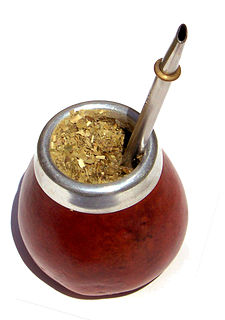 W
WMate or maté also known as chimarrão or cimarrón, is a traditional South American caffeine-rich infused drink. It is made by soaking dried leaves of the holly species Ilex paraguariensis in hot water and is served with a metal straw in a container typically made from a calabash gourd.
 W
WMate cocido, maté tea, kojoi, or yerbiado is an infusion typical of Southern Cone cuisine. It is traditionally prepared by boiling yerba mate in water, then strained and served in cups. It is a bitter tasting beverage, similar to mate but milder, with the same stimulating and nutritional properties. It is also sold in tea-bags, so it can be prepared like tea.
 W
WNational Tea Day is observed in the United Kingdom every year on 21 April to celebrate the drinking of tea. It is celebrated in tea rooms, hotels, pubs and cafés through special events, and charitable fundraising events held across the country, including a tea 'Fes-Tea-Val' at Chiswick House & Gardens in London. Tea brands and press outlets run promotions and features in conjunction with the day, including The Independent, Metro and The Telegraph, as well as local newspapers.
 W
WNepali tea is a beverage made from the leaves of tea plants grown in Nepal. They are distinctive in appearance, aroma and taste, but are similar in many ways to tea produced in Darjeeling tea, perhaps because the eastern zones of Nepal have geography and topography similar to Darjeeling. Its relatively smaller production quantities mean that teas from Nepal are less well known than those from Darjeeling.
 W
WNoon chai, also called shir chai, gulabi chai, Kashmiri tea or pink tea, is a traditional tea beverage, originating from the Kashmir Valley, made with gunpowder tea, milk and baking soda.
 W
WA tea party is a gathering for the small meal called afternoon tea.
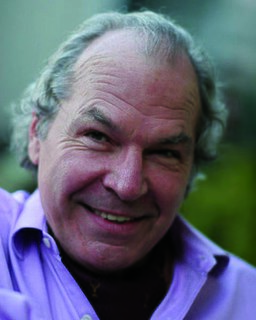 W
WJames Norwood Pratt is an American author, educator, and speaker, on the topics of wine, tea, and tea lore. Known as "America's Tea Sage," he is possibly the world's most widely read authority on tea and tea lore.
 W
WIn the middle third of the 19th century, the clippers which carried cargoes of tea from China to Britain would compete in informal races to be first ship to dock in London with the new crop of each season. The Great Tea Race of 1866 was keenly followed in the press, with an extremely close finish. Taeping docked 28 minutes before Ariel - after a passage of more than 14,000 miles. Ariel had been ahead when the ships were taken in tow by steam tugs off Deal, but after waiting for the tide at Gravesend the deciding factor was the height of tide at which one could enter the different docks used by each ship. The third finisher, Serica, docked an hour and 15 minutes after Ariel. These three ships had left China on the same tide and arrived at London 99 days later to dock on the same tide. The next to arrive, 28 hours later, was Fiery Cross, followed, the next day, by Taitsing.
 W
WTea has long been used as an umbrella term for several different meals. English writer Isabella Beeton, whose books on home economics were widely read in the 19th century, describes meals of various kinds and provides menus for the "old-fashioned tea", the "at-home tea", the "family tea", and the "high tea".
 W
WThis is a list of countries ordered by annual per capita consumption of tea, as of 2016.
 W
WA tea garden is a garden where tea and light refreshments are served, a tea plantation, or any garden with which the drinking of tea is associated. Often a peaceful place for a stroll or social event, the tea garden is a smaller form of a pleasure garden.
 W
WTea Garden Express is an overnight regional rail connecting Karaikal in Union territory of Puducherry with Ernakulam in Kerala via Thiruvarur Junction, Thanjavur Junction, Tiruchirappalli Junction, Karur Junction, Coimbatore Junction, Palakkad Junction.
 W
WA teahouse or tearoom is an establishment which primarily serves tea and other light refreshments. A tea room may be a room set aside in a hotel especially for serving afternoon tea, or may be an establishment which only serves cream teas. Although the function of a tearoom may vary according to the circumstance or country, teahouses often serve as centers of social interaction, like coffeehouses.
 W
WA tea lady provides drinks in an office, factory, hospital, or other place of work. The role under this name began in Britain during World War II, and continues in the National Health Service today. It used to be a wide-spread occupation for women, and as such was well represented in popular culture.
 W
WA tea pet or tea lover's pet, also known as tea friend, is a small clay figure which is kept by some tea drinkers for good luck. They are usually made of "zisha" or Yixing clay, from the region near Yixing in Jiangsu province, China. Just like Yixing teapots made of the same clay, tea pets are unglazed, and are mostly monochromatic with a rough surface.
 W
WTeh tarik is a popular hot milk tea beverage most commonly found in restaurants, outdoor stalls, mamaks and kopitiams within the Southeast Asian countries of Malaysia, Indonesia and Singapore. Its name is derived from the pouring process of "pulling" the drink during preparation. It is made from a strong brew of black tea blended with condensed milk. It is the national drink of Malaysia.
 W
WTereré or terere is an infusion of yerba mate, similar to mate but prepared with cold water and ice rather than with hot water, and in a slightly larger vessel. This infusion has its roots in Pre-Columbian America, which established itself as traditional during the time of Governorate of Paraguay. The Guaraní people call this infusion ka'ay, where ka'a means herb and y means water.
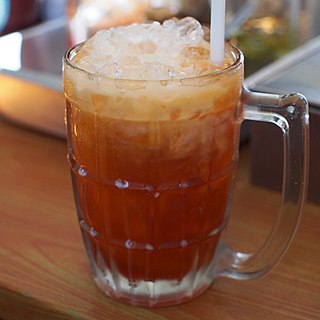 W
WThai tea is usually known as a Thai drink made from Ceylon tea, milk and sugar, and served hot or cold. It is popular in Southeast Asia and is served in many restaurants that serve Thai food. When served cold it is known as Thai iced tea.
 W
WWagashi are traditional Japanese confections that are often served with green tea, especially the types made of mochi, anko, and fruit. Wagashi are typically made from plant-based ingredients.
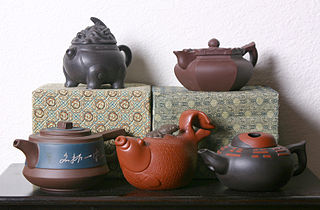 W
WYixing clay is a type of clay from the region near the city of Yixing in Jiangsu Province, China, used in Chinese pottery since the Song dynasty (960–1279) when Yixing clay was first mined around China's Lake Tai. From the 17th century on, Yixing wares were commonly exported to Europe. The finished stoneware, which is used for teaware and other small items, is usually red or brown in colour. Also known as zisha (宜興紫砂) ware, they are typically left unglazed and use clays that are very cohesive and can form coils, slabs and most commonly slip casts. These clays can also be formed by throwing. The best known wares made from Yixing clay are Yixing clay teapots, tea pets, and other teaware.
 W
WYum cha is the Cantonese tradition of brunch involving Chinese tea and dim sum. The practice is popular in Cantonese-speaking regions, including Guangdong province, Guangxi province, Hong Kong, and Macau. It is also carried out in other regions worldwide where there are overseas Cantonese communities. Yum cha generally involves small portions of steamed, pan-fried, or deep-fried dim sum dishes served in bamboo steamers, which are designed to be eaten communally and washed down with hot tea. People often go to yum cha in large groups for family gatherings and celebrations.